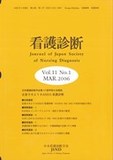Japanese
English
- 有料閲覧
- Abstract 文献概要
- 参考文献 Reference
NANDA-NOC-NICを導入し,看護実践してきたがNOCの評価の際,各看護師間で評価によるばらつきを認めていた.そこで今回,NOC「嚥下の状態:咽頭の段階」のなかから,「タイミングのよい嚥下反射」,「声の質」,「窒息や咳,むせがない」,「頭部を真っすぐに保つ」の4つの指標の評価基準を作成し,これを嚥下障害が認められた患者に使用し,その前後で看護師間の評価の差を比較した.その結果,評価基準作成前は評価のばらつきが大きかったが,評価基準作成後は評価が一致していた.評価基準を作成することでNOCの5段階尺度が明確になり,尺度を共有しやすくなった.また,評価が一致したことで使用しやすくなり,測定の時間が短縮できた.このことから,尺度の評価基準を作成することによって臨床でNOCの継続した使用の可能性が高くなったといえる.
We have been practicing nursing in accordance with the NANDA-NOC-NIC. However, in evaluations made using the NOC there were notable variations among the nurses. To solve this problem, we created evaluation standards for the four indicators from the“Swallowing Status: Pharyngeal Phase”in the NOC. These indicators are“timely swallowing reflex,”“voice quality,”“no suffocation, coughs or choking,”and “maintaining his/her head straight up.”We applied these standards to evaluate individual patients with swallowing difficulty and compared variances in nurses' evaluations before and after the application. The results showed that, although there had been a wide variation in evaluations before the introduction of evaluation standards, they were consistent when the standards were used. The evaluation standards that were developed have made the NOC 5-point scale clearer and, therefore, easier to share. In addition, evaluation consistency made the use easier, shortening the evaluation time. These allow us to conclude that the development of evaluation standards for the scale enhanced the possibility of continued use of NOC in the clinical setting.
Copyright © 2006, Japan Society of Nursing Diagnosis. All rights reserved.


